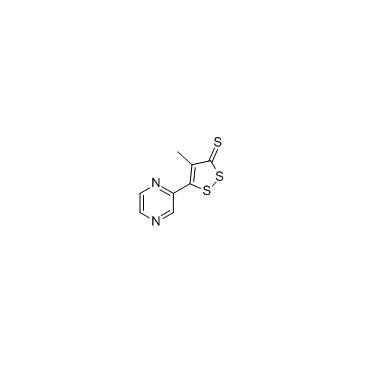Oltipraz

Oltipraz structure
|
Common Name | Oltipraz | ||
|---|---|---|---|---|
| CAS Number | 64224-21-1 | Molecular Weight | 226.342 | |
| Density | 1.5±0.1 g/cm3 | Boiling Point | 408.1±55.0 °C at 760 mmHg | |
| Molecular Formula | C8H6N2S3 | Melting Point | 165-166ºC | |
| MSDS | Chinese USA | Flash Point | 200.6±31.5 °C | |
| Symbol |

GHS07 |
Signal Word | Warning | |
|
Catalase overexpression prevents nuclear factor erythroid 2-related factor 2 stimulation of renal angiotensinogen gene expression, hypertension, and kidney injury in diabetic mice.
Diabetes 63(10) , 3483-96, (2014) This study investigated the impact of catalase (Cat) overexpression in renal proximal tubule cells (RPTCs) on nuclear factor erythroid 2-related factor 2 (Nrf2) stimulation of angiotensinogen (Agt) gene expression and the development of hypertension and renal... |
|
|
Antioxidant and mitochondrial protective effects of oxidized metabolites of oltipraz.
Expert Opin. Drug Metab. Toxicol. 6(2) , 213-24, (2010) Comprehensive studies indicate that oltipraz exerts cancer chemopreventive effects. Oltipraz has other therapeutic potentials, which include anti-fibrotic effect, inhibition of insulin resistance, mitochondrial protection and cytoprotective effect against oxi... |
|
|
Inhibition of colon carcinogenesis by post-initiation induction of NQO1 in Sprague-Dawley rats.
Oncol. Rep. 21(6) , 1559-65, (2009) Inducers of phase II detoxifying enzymes have been studied as chemopreventive agents for a variety of cancers. Phase II detoxifying enzymes may play a significant role in preventing carcinogen-induced colon cancer at the initiation and post-initiation stage, ... |
|
|
Oltipraz promotion of liver regeneration after partial hepatectomy: The role of PI3-kinase-dependent C/EBPbeta and cyclin E regulation.
Arch. Pharm. Res. 32(4) , 625-35, (2009) Oltipraz, a representative cancer chemopreventive agent, regenerates cirrhotic liver via CCAAT/enhancer binding protein beta (C/EBPbeta). This study examined the effect of oltipraz on liver regeneration after partial hepatectomy (PH) and explored the role of ... |
|
|
Pharmacokinetic interaction between oltipraz and silymarin in rats.
J. Pharm. Pharm. Sci. 12(1) , 1-16, (2009) To evaluate the pharmacokinetic interaction between oltipraz and silymarin after intravenous and oral administration of both drugs to male Sprague-Dawley rats.Oltipraz (single doses of 10 and 30 mg/kg for intravenous and oral administration, respectively), si... |
|
|
This month in APR.
Arch. Pharm. Res. 32(4) , 463-4, (2009)
|
|
|
Hydrogen peroxide is a second messenger in phase 2 enzyme induction by cancer chemopreventive dithiolethiones.
Chem. Res. Toxicol. 22(8) , 1427-34, (2009) The ability of three dithiolethione cancer chemopreventives, oltipraz 1, anetholedithione (ADT) 2, 1,2-dithiole-3-thione (D3T) 3, and the major metabolite, 4, of 1, to induce the cytoprotective enzyme NQO1 in Hepa 1c1c7 cells and the inhibition of this induct... |
|
|
Therapeutic potential of dithiolethiones for hepatic diseases.
Pharmacol. Ther. 124(1) , 31-43, (2009) Comprehensive studies support the notion that oltipraz [4-methyl-5-(2-pyrazynyl)-1,2-dithiole-3-thione] and its congeners exert cancer chemopreventive effects by the prevention, inhibition or reversal of carcinogenic processes. Recently, it was found that dit... |
|
|
Handling the limit of detection by extrapolation.
Stat. Med. 31(26) , 3133-46, (2012) A general method of estimation with a variable observed subject to a limit of detection is introduced. It is based on extrapolation of the estimates obtained by increasing the limit of detection. Theoretical arguments support the method in some special cases,... |
|
|
Cancer chemoprotection by oltipraz: experimental and clinical considerations.
Prev. Med. 22(5) , 783-95, (1993) Oltipraz (4-methyl-5-(2-pyrazinyl)-1,2-dithiole-3-thione) is an antischistosomal drug presently under evaluation as a possible chemoprotective agent in humans. To date, oltipraz has proved effective as an inhibitor of carcinogenesis in experimental models for... |